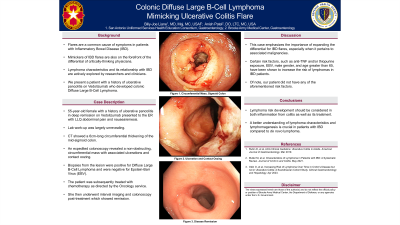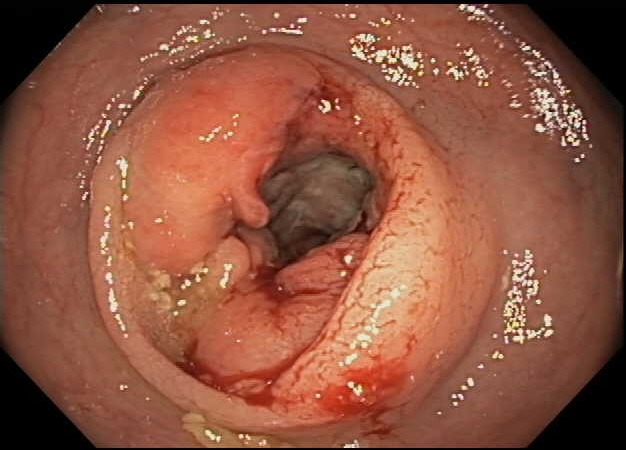Monday Poster Session
Category: IBD
P2257 - Colonic Diffuse Large B-Cell Lymphoma Mimicking Ulcerative Colitis Flare
Monday, October 23, 2023
10:30 AM - 4:15 PM PT
Location: Exhibit Hall

Has Audio

Billy-Joe Liane, MD
Brooke Army Medical Center
San Antonio, TX
Presenting Author(s)
Billy-Joe Liane, MD, Anish Patel, DO
Brooke Army Medical Center, San Antonio, TX
Introduction: We present a case of a 55-year-old female with history of ulcerative pancolitis on Vedolizumab who developed colonic Diffuse Large B-Cell Lymphoma, prompting deeper exploration of the relationship between Inflammatory Bowel Disease (IBD) and lymphoma incidence.
Case Description/Methods: The patient has had ulcerative colitis since the age of 30 and has been maintained in clinical and endoscopic remission on Vedolizumab. She has not had prior exposure to neither anti-tumor necrosis factors (anti-TNFs) nor immunomodulator therapy. She began having cramping abdominal pain, localized to the mid-epigastric area and the left lower quadrant, associated with nausea and bouts of emesis, progressively getting worse, and eventually triggering presentation to the emergency department. Preliminary laboratory work-up was largely unrevealing. A cross-sectional abdominal imaging study, however, showed the presence of circumferential thickening of the mid-sigmoid colon involving approximately 6 cm and measuring up to 2 cm in thickening without luminal narrowing or adjacent inflammatory change. The patient subsequently had a close follow-up at the Gastroenterology department along with an expedited colonoscopy for direct visualization and tissue acquisition. The endoscopic examination revealed a 5-6 cm non-obstructing circumferential area of friability, edema, erythema, and ulceration, which was concordant with the imaging findings. Multiple biopsies were obtained from the abnormal area. These showed Diffuse Large B-Cell Lymphoma and were negative for Epstein-Barr virus (EBV). The patient was notified of the results and was referred to the Oncology service, who defined the patient’s disease stage as limited and offered 3 cycles of chemotherapy along with radiation therapy, which she completed and tolerated. The patient then had an interval imaging and colonoscopy which showed disease remission.
Discussion: This case emphasizes the importance of keeping a differential diagnosis broader than a flare for IBD patients who develop gastrointestinal symptoms, especially when it pertains to associated malignancies. While certain critical factors, such as anti-TNF and/or thiopurine exposure, EBV, male gender, and age greater than 65 years old, have been shown in literature to increase the risk of lymphomas in IBD patients, our patient did not have any of these risk factors. Therefore, a better understanding of lymphoma characteristics and lymphomagenesis is crucial in patients with IBD compared to de novo lymphoma.

Disclosures:
Billy-Joe Liane, MD, Anish Patel, DO. P2257 - Colonic Diffuse Large B-Cell Lymphoma Mimicking Ulcerative Colitis Flare, ACG 2023 Annual Scientific Meeting Abstracts. Vancouver, BC, Canada: American College of Gastroenterology.
Brooke Army Medical Center, San Antonio, TX
Introduction: We present a case of a 55-year-old female with history of ulcerative pancolitis on Vedolizumab who developed colonic Diffuse Large B-Cell Lymphoma, prompting deeper exploration of the relationship between Inflammatory Bowel Disease (IBD) and lymphoma incidence.
Case Description/Methods: The patient has had ulcerative colitis since the age of 30 and has been maintained in clinical and endoscopic remission on Vedolizumab. She has not had prior exposure to neither anti-tumor necrosis factors (anti-TNFs) nor immunomodulator therapy. She began having cramping abdominal pain, localized to the mid-epigastric area and the left lower quadrant, associated with nausea and bouts of emesis, progressively getting worse, and eventually triggering presentation to the emergency department. Preliminary laboratory work-up was largely unrevealing. A cross-sectional abdominal imaging study, however, showed the presence of circumferential thickening of the mid-sigmoid colon involving approximately 6 cm and measuring up to 2 cm in thickening without luminal narrowing or adjacent inflammatory change. The patient subsequently had a close follow-up at the Gastroenterology department along with an expedited colonoscopy for direct visualization and tissue acquisition. The endoscopic examination revealed a 5-6 cm non-obstructing circumferential area of friability, edema, erythema, and ulceration, which was concordant with the imaging findings. Multiple biopsies were obtained from the abnormal area. These showed Diffuse Large B-Cell Lymphoma and were negative for Epstein-Barr virus (EBV). The patient was notified of the results and was referred to the Oncology service, who defined the patient’s disease stage as limited and offered 3 cycles of chemotherapy along with radiation therapy, which she completed and tolerated. The patient then had an interval imaging and colonoscopy which showed disease remission.
Discussion: This case emphasizes the importance of keeping a differential diagnosis broader than a flare for IBD patients who develop gastrointestinal symptoms, especially when it pertains to associated malignancies. While certain critical factors, such as anti-TNF and/or thiopurine exposure, EBV, male gender, and age greater than 65 years old, have been shown in literature to increase the risk of lymphomas in IBD patients, our patient did not have any of these risk factors. Therefore, a better understanding of lymphoma characteristics and lymphomagenesis is crucial in patients with IBD compared to de novo lymphoma.

Figure: Sigmoid colon circumferential thickening with associated friability, erythema, and ulceration
Disclosures:
Billy-Joe Liane indicated no relevant financial relationships.
Anish Patel indicated no relevant financial relationships.
Billy-Joe Liane, MD, Anish Patel, DO. P2257 - Colonic Diffuse Large B-Cell Lymphoma Mimicking Ulcerative Colitis Flare, ACG 2023 Annual Scientific Meeting Abstracts. Vancouver, BC, Canada: American College of Gastroenterology.

